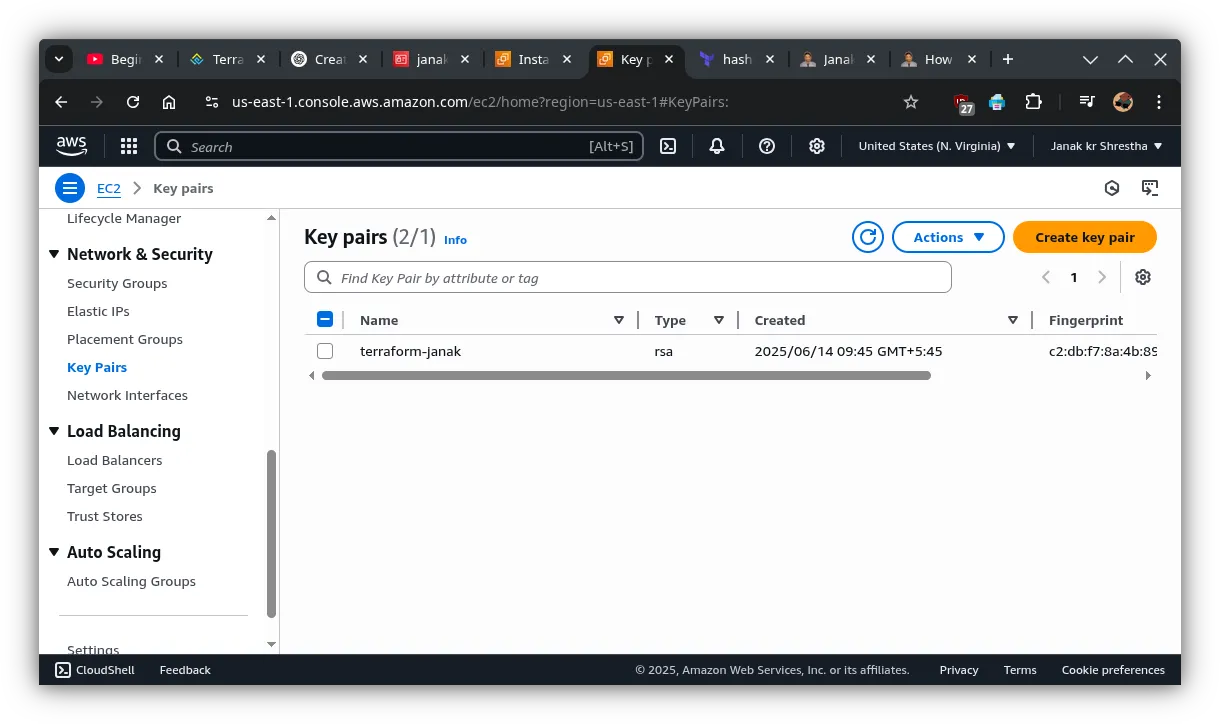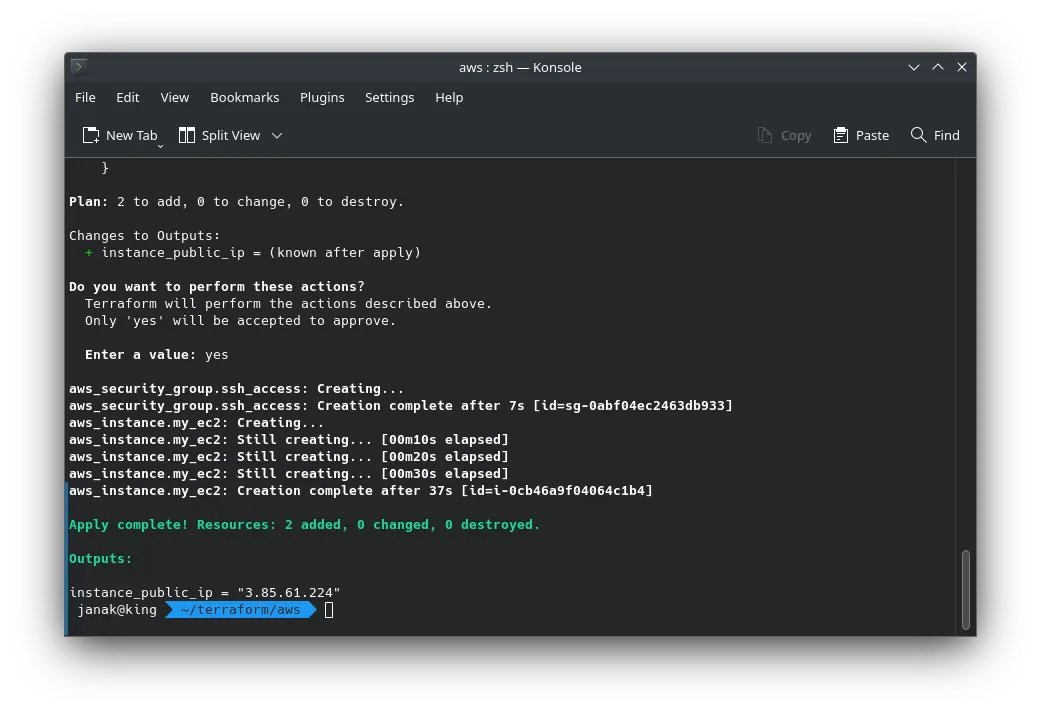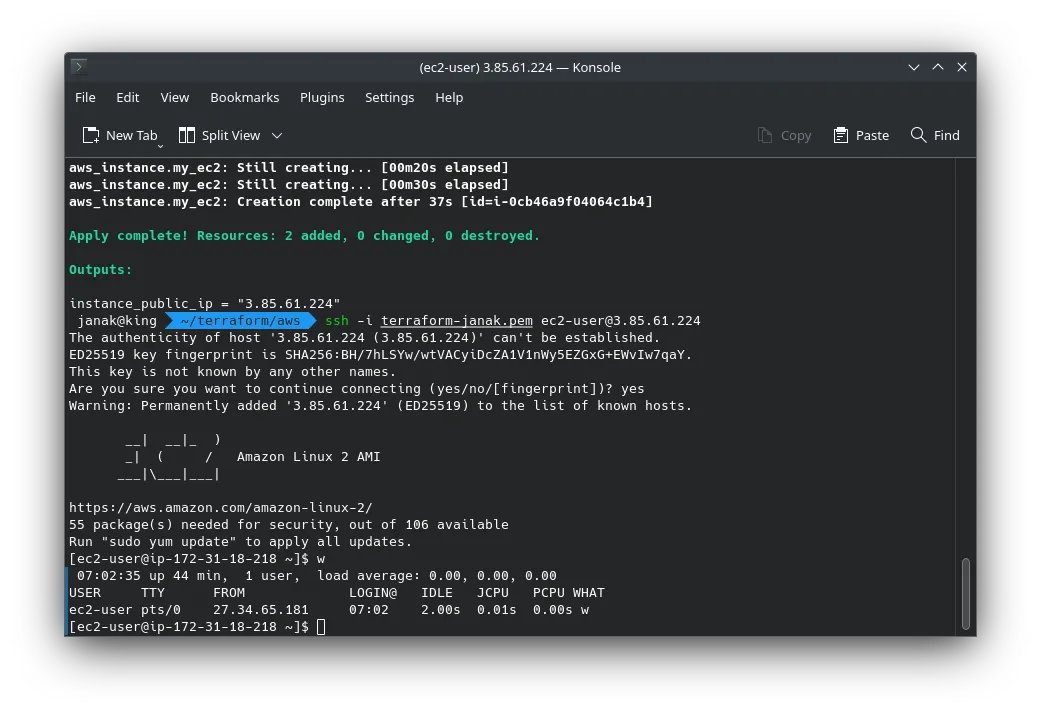step-by-step to create a Virtual Machine (EC2 instance) on AWS Free Tier using Terraform and SSH to it.
Create a key pair in AWS Console (if you don’t have one)
- Go to: AWS Console → EC2 → Key Pairs
- Click Create key pair
- Name:
my-key - Type: RSA
- Save the
.pemfile (e.g.,my-key.pem) securely

Download and move it to your project Directory and Check Permissions of the .pem File
chmod 400 my-key.pem✅ Install Required Packages
1. Install AWS CLI
sudo apt update
sudo apt install awscli -yVerify:
aws --version2. Install Terraform
sudo apt-get update && sudo apt-get install -y gnupg software-properties-common curl
curl -fsSL https://apt.releases.hashicorp.com/gpg | sudo gpg --dearmor -o /usr/share/keyrings/hashicorp-archive-keyring.gpg
echo "deb [signed-by=/usr/share/keyrings/hashicorp-archive-keyring.gpg] https://apt.releases.hashicorp.com $(lsb_release -cs) main" | sudo tee /etc/apt/sources.list.d/hashicorp.list
sudo apt update
sudo apt install terraform -yVerify:
terraform -version✅ Configure AWS CLI
💡 Get access keys from: AWS Console > IAM > Users > Your Username > Security Credentials > Access Keys

aws configureEnter the following:
- AWS Access Key ID
- AWS Secret Access Key
- Region (e.g.,
us-east-1) - Output format: Just press Enter
After this steps, two files are auto created inside /home/username/.aws

✅ Create Terraform Configuration
1. Create a folder
mkdir terraform-aws
cd terraform-aws2. Create main.tf
nano main.tfPaste the following:
# --------------------------------------------------
# Terraform block to specify required providers
# --------------------------------------------------
terraform {
required_providers {
aws = {
source = "hashicorp/aws"
version = "~> 5.0" # Using a stable version of AWS provider
}
}
}
# --------------------------------------------------
# AWS provider configuration
# --------------------------------------------------
provider "aws" {
region = "us-east-1" # AWS region to deploy resources
}
# --------------------------------------------------
# Data block to fetch default VPC (used by security group)
# --------------------------------------------------
data "aws_vpc" "default" {
default = true
}
# --------------------------------------------------
# Security group resource to allow SSH access
# --------------------------------------------------
resource "aws_security_group" "ssh_access" {
name = "allow_ssh"
description = "Allow SSH inbound traffic"
vpc_id = data.aws_vpc.default.id # Attach to the default VPC
# Inbound rule to allow SSH from any IP
ingress {
description = "SSH from anywhere"
from_port = 22
to_port = 22
protocol = "tcp"
cidr_blocks = ["0.0.0.0/0"] # ⚠️ For production, replace with your IP (e.g. ["203.0.113.0/32"])
}
# Outbound rule to allow all traffic
egress {
from_port = 0
to_port = 0
protocol = "-1"
cidr_blocks = ["0.0.0.0/0"]
}
}
# --------------------------------------------------
# EC2 instance resource
# --------------------------------------------------
resource "aws_instance" "my_ec2" {
ami = "ami-0c2b8ca1dad447f8a" # Amazon Linux 2 AMI (Free tier eligible)
instance_type = "t2.micro" # Free tier eligible instance type
key_name = "terraform-janak" # Replace with the name of your existing AWS EC2 key pair
security_groups = [aws_security_group.ssh_access.name] # Attach the SSH security group
tags = {
Name = "MyTerraformVM" # Tag to identify your instance
}
}
# --------------------------------------------------
# Output block to show the public IP of the EC2 instance
# --------------------------------------------------
output "instance_public_ip" {
description = "Public IP of the EC2 instance"
value = aws_instance.my_ec2.public_ip
}
✅ Save & close (Ctrl + O, Enter, Ctrl + X)
✅ Initialize Terraform
terraform init✅ Code Formatting Terraform (optional)
terraform fmt✅ Validate Configuration
terraform validate✅ Apply the Configuration
terraform applyIt will show you a plan. Type yes to proceed.

✅ Access Your EC2 Instance via SSH from your linxu machine.
ssh -i my-key.pem ec2-user@<public_ip>📝 Use ec2-user for Amazon Linux AMI (or ubuntu if you switch to Ubuntu AMI).


✅ Destroy the Instance
terraform destroy✅ terraform refresh — What It Does
terraform refreshThe terraform refresh command is used to:
Sync the Terraform state file with the actual current state of resources in your AWS (or other) infrastructure.
In other words:
It checks what exists in real AWS and updates Terraform’s .tfstate file to reflect any changes that happened outside of Terraform.
📖 References & Further Reading
-
Terraform Plans, Modules, and Remote State – by Wahl Network A great explanation of how Terraform handles infrastructure planning, modularization, and remote state management. 🔗 https://wahlnetwork.com/2020/04/29/terraform-plans-modules-and-remote-state/
-
Terraform AWS Provider Documentation – Official Registry The complete reference for all AWS resources supported in Terraform, including syntax, arguments, and examples. 🔗 https://registry.terraform.io/providers/hashicorp/aws/latest
Output of my terminal:
janak@king ~/terraform/aws terraform validate
Success! The configuration is valid.
janak@king ~/terraform/aws terraform fmt
main.tf
janak@king ~/terraform/aws terraform apply
data.aws_vpc.default: Reading...
data.aws_vpc.default: Read complete after 3s [id=vpc-0bdb14565e290df3b]
Terraform used the selected providers to generate the following execution plan. Resource actions are
indicated with the following symbols:
+ create
Terraform will perform the following actions:
# aws_instance.my_ec2 will be created
+ resource "aws_instance" "my_ec2" {
+ ami = "ami-0c2b8ca1dad447f8a"
+ arn = (known after apply)
+ associate_public_ip_address = (known after apply)
+ availability_zone = (known after apply)
+ cpu_core_count = (known after apply)
+ cpu_threads_per_core = (known after apply)
+ disable_api_stop = (known after apply)
+ disable_api_termination = (known after apply)
+ ebs_optimized = (known after apply)
+ enable_primary_ipv6 = (known after apply)
+ get_password_data = false
+ host_id = (known after apply)
+ host_resource_group_arn = (known after apply)
+ iam_instance_profile = (known after apply)
+ id = (known after apply)
+ instance_initiated_shutdown_behavior = (known after apply)
+ instance_lifecycle = (known after apply)
+ instance_state = (known after apply)
+ instance_type = "t2.micro"
+ ipv6_address_count = (known after apply)
+ ipv6_addresses = (known after apply)
+ key_name = "terraform-janak"
+ monitoring = (known after apply)
+ outpost_arn = (known after apply)
+ password_data = (known after apply)
+ placement_group = (known after apply)
+ placement_partition_number = (known after apply)
+ primary_network_interface_id = (known after apply)
+ private_dns = (known after apply)
+ private_ip = (known after apply)
+ public_dns = (known after apply)
+ public_ip = (known after apply)
+ secondary_private_ips = (known after apply)
+ security_groups = [
+ "allow_ssh",
]
+ source_dest_check = true
+ spot_instance_request_id = (known after apply)
+ subnet_id = (known after apply)
+ tags = {
+ "Name" = "MyTerraformVM"
}
+ tags_all = {
+ "Name" = "MyTerraformVM"
}
+ tenancy = (known after apply)
+ user_data = (known after apply)
+ user_data_base64 = (known after apply)
+ user_data_replace_on_change = false
+ vpc_security_group_ids = (known after apply)
+ capacity_reservation_specification (known after apply)
+ cpu_options (known after apply)
+ ebs_block_device (known after apply)
+ enclave_options (known after apply)
+ ephemeral_block_device (known after apply)
+ instance_market_options (known after apply)
+ maintenance_options (known after apply)
+ metadata_options (known after apply)
+ network_interface (known after apply)
+ private_dns_name_options (known after apply)
+ root_block_device (known after apply)
}
# aws_security_group.ssh_access will be created
+ resource "aws_security_group" "ssh_access" {
+ arn = (known after apply)
+ description = "Allow SSH inbound traffic"
+ egress = [
+ {
+ cidr_blocks = [
+ "0.0.0.0/0",
]
+ from_port = 0
+ ipv6_cidr_blocks = []
+ prefix_list_ids = []
+ protocol = "-1"
+ security_groups = []
+ self = false
+ to_port = 0
# (1 unchanged attribute hidden)
},
]
+ id = (known after apply)
+ ingress = [
+ {
+ cidr_blocks = [
+ "0.0.0.0/0",
]
+ description = "SSH from anywhere"
+ from_port = 22
+ ipv6_cidr_blocks = []
+ prefix_list_ids = []
+ protocol = "tcp"
+ security_groups = []
+ self = false
+ to_port = 22
},
]
+ name = "allow_ssh"
+ name_prefix = (known after apply)
+ owner_id = (known after apply)
+ revoke_rules_on_delete = false
+ tags_all = (known after apply)
+ vpc_id = "vpc-0bdb14565e290df3b"
}
Plan: 2 to add, 0 to change, 0 to destroy.
Changes to Outputs:
+ instance_public_ip = (known after apply)
Do you want to perform these actions?
Terraform will perform the actions described above.
Only 'yes' will be accepted to approve.
Enter a value: yes
aws_security_group.ssh_access: Creating...
aws_security_group.ssh_access: Creation complete after 7s [id=sg-0abf04ec2463db933]
aws_instance.my_ec2: Creating...
aws_instance.my_ec2: Still creating... [00m10s elapsed]
aws_instance.my_ec2: Still creating... [00m20s elapsed]
aws_instance.my_ec2: Still creating... [00m30s elapsed]
aws_instance.my_ec2: Creation complete after 37s [id=i-0cb46a9f04064c1b4]
Apply complete! Resources: 2 added, 0 changed, 0 destroyed.
Outputs:
instance_public_ip = "3.85.61.224"
janak@king ~/terraform/aws ssh -i terraform-janak.pem [email protected]
The authenticity of host '3.85.61.224 (3.85.61.224)' can't be established.
ED25519 key fingerprint is SHA256:BH/7hLSYw/wtVACyiDcZA1V1nWy5EZGxG+EWvIw7qaY.
This key is not known by any other names.
Are you sure you want to continue connecting (yes/no/[fingerprint])? yes
Warning: Permanently added '3.85.61.224' (ED25519) to the list of known hosts.
__| __|_ )
_| ( / Amazon Linux 2 AMI
___|\___|___|
https://aws.amazon.com/amazon-linux-2/
55 package(s) needed for security, out of 106 available
Run "sudo yum update" to apply all updates.
[ec2-user@ip-172-31-18-218 ~]$ w
07:02:35 up 44 min, 1 user, load average: 0.00, 0.00, 0.00
USER TTY FROM LOGIN@ IDLE JCPU PCPU WHAT
ec2-user pts/0 27.34.65.181 07:02 2.00s 0.01s 0.00s w
[ec2-user@ip-172-31-18-218 ~]$ exit
logout
Connection to 3.85.61.224 closed.
janak@king ~/terraform/aws terraform destroy
data.aws_vpc.default: Reading...
data.aws_vpc.default: Read complete after 3s [id=vpc-0bdb14565e290df3b]
aws_security_group.ssh_access: Refreshing state... [id=sg-0abf04ec2463db933]
aws_instance.my_ec2: Refreshing state... [id=i-0cb46a9f04064c1b4]
Terraform used the selected providers to generate the following execution plan. Resource actions are
indicated with the following symbols:
- destroy
Terraform will perform the following actions:
# aws_instance.my_ec2 will be destroyed
- resource "aws_instance" "my_ec2" {
- ami = "ami-0c2b8ca1dad447f8a" -> null
- arn = "arn:aws:ec2:us-east-1:442042544656:instance/i-0cb46a9f04064c1b4" -> null
- associate_public_ip_address = true -> null
- availability_zone = "us-east-1d" -> null
- cpu_core_count = 1 -> null
- cpu_threads_per_core = 1 -> null
- disable_api_stop = false -> null
- disable_api_termination = false -> null
- ebs_optimized = false -> null
- get_password_data = false -> null
- hibernation = false -> null
- id = "i-0cb46a9f04064c1b4" -> null
- instance_initiated_shutdown_behavior = "stop" -> null
- instance_state = "running" -> null
- instance_type = "t2.micro" -> null
- ipv6_address_count = 0 -> null
- ipv6_addresses = [] -> null
- key_name = "terraform-janak" -> null
- monitoring = false -> null
- placement_partition_number = 0 -> null
- primary_network_interface_id = "eni-09c381fcd7f2a599f" -> null
- private_dns = "ip-172-31-18-218.ec2.internal" -> null
- private_ip = "172.31.18.218" -> null
- public_dns = "ec2-3-85-61-224.compute-1.amazonaws.com" -> null
- public_ip = "3.85.61.224" -> null
- secondary_private_ips = [] -> null
- security_groups = [
- "allow_ssh",
] -> null
- source_dest_check = true -> null
- subnet_id = "subnet-0eb9138e4799cbcd9" -> null
- tags = {
- "Name" = "MyTerraformVM"
} -> null
- tags_all = {
- "Name" = "MyTerraformVM"
} -> null
- tenancy = "default" -> null
- user_data_replace_on_change = false -> null
- vpc_security_group_ids = [
- "sg-0abf04ec2463db933",
] -> null
# (7 unchanged attributes hidden)
- capacity_reservation_specification {
- capacity_reservation_preference = "open" -> null
}
- cpu_options {
- core_count = 1 -> null
- threads_per_core = 1 -> null
# (1 unchanged attribute hidden)
}
- credit_specification {
- cpu_credits = "standard" -> null
}
- enclave_options {
- enabled = false -> null
}
- maintenance_options {
- auto_recovery = "default" -> null
}
- metadata_options {
- http_endpoint = "enabled" -> null
- http_protocol_ipv6 = "disabled" -> null
- http_put_response_hop_limit = 1 -> null
- http_tokens = "optional" -> null
- instance_metadata_tags = "disabled" -> null
}
- private_dns_name_options {
- enable_resource_name_dns_a_record = false -> null
- enable_resource_name_dns_aaaa_record = false -> null
- hostname_type = "ip-name" -> null
}
- root_block_device {
- delete_on_termination = true -> null
- device_name = "/dev/xvda" -> null
- encrypted = false -> null
- iops = 100 -> null
- tags = {} -> null
- tags_all = {} -> null
- throughput = 0 -> null
- volume_id = "vol-00b407383785fadd0" -> null
- volume_size = 8 -> null
- volume_type = "gp2" -> null
# (1 unchanged attribute hidden)
}
}
# aws_security_group.ssh_access will be destroyed
- resource "aws_security_group" "ssh_access" {
- arn = "arn:aws:ec2:us-east-1:442042544656:security-group/sg-0abf04ec2463db933" -> null
- description = "Allow SSH inbound traffic" -> null
- egress = [
- {
- cidr_blocks = [
- "0.0.0.0/0",
]
- from_port = 0
- ipv6_cidr_blocks = []
- prefix_list_ids = []
- protocol = "-1"
- security_groups = []
- self = false
- to_port = 0
# (1 unchanged attribute hidden)
},
] -> null
- id = "sg-0abf04ec2463db933" -> null
- ingress = [
- {
- cidr_blocks = [
- "0.0.0.0/0",
]
- description = "SSH from anywhere"
- from_port = 22
- ipv6_cidr_blocks = []
- prefix_list_ids = []
- protocol = "tcp"
- security_groups = []
- self = false
- to_port = 22
},
] -> null
- name = "allow_ssh" -> null
- owner_id = "442042544656" -> null
- revoke_rules_on_delete = false -> null
- tags = {} -> null
- tags_all = {} -> null
- vpc_id = "vpc-0bdb14565e290df3b" -> null
# (1 unchanged attribute hidden)
}
Plan: 0 to add, 0 to change, 2 to destroy.
Changes to Outputs:
- instance_public_ip = "3.85.61.224" -> null
Do you really want to destroy all resources?
Terraform will destroy all your managed infrastructure, as shown above.
There is no undo. Only 'yes' will be accepted to confirm.
Enter a value: yes
aws_instance.my_ec2: Destroying... [id=i-0cb46a9f04064c1b4]
aws_instance.my_ec2: Still destroying... [id=i-0cb46a9f04064c1b4, 00m10s elapsed]
aws_instance.my_ec2: Still destroying... [id=i-0cb46a9f04064c1b4, 00m20s elapsed]
aws_instance.my_ec2: Still destroying... [id=i-0cb46a9f04064c1b4, 00m30s elapsed]
aws_instance.my_ec2: Still destroying... [id=i-0cb46a9f04064c1b4, 00m40s elapsed]
aws_instance.my_ec2: Destruction complete after 44s
aws_security_group.ssh_access: Destroying... [id=sg-0abf04ec2463db933]
aws_security_group.ssh_access: Destruction complete after 1s
Destroy complete! Resources: 2 destroyed.
janak@king ~/terraform/aws